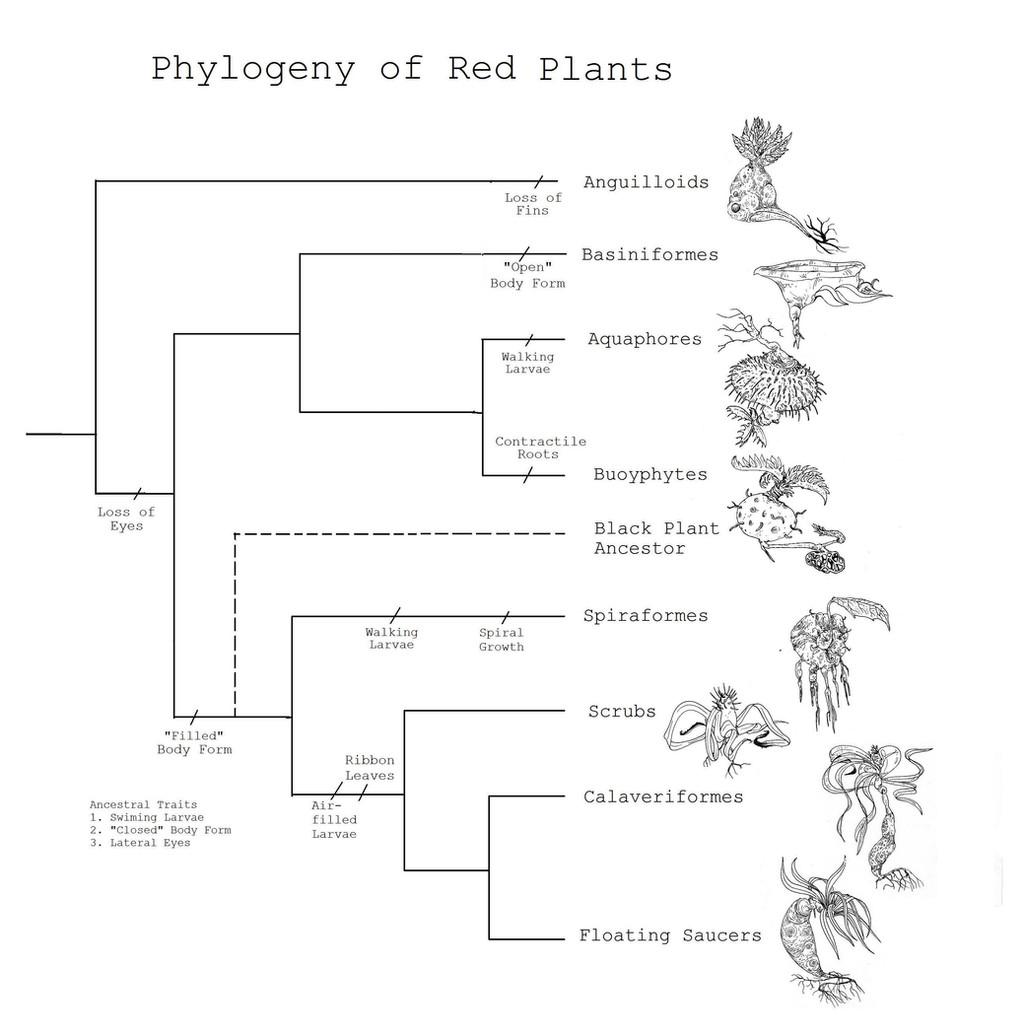HOME | DD
 Malicious-Monkey — Phylogeny of Red Plants
Malicious-Monkey — Phylogeny of Red Plants

Published: 2013-04-26 03:46:22 +0000 UTC; Views: 2358; Favourites: 29; Downloads: 20
Redirect to original
Description
So, this was definitely the hardest cladogram I’ve made so far. The plants had to resemble each other if they were related, but more importantly they had to have the same kind of larvae. I started by drawing a bunch of larvae, then a bunch of plants. I ended up dividing them between ancestral fishlike swimmers and derived jellyfishlike floaters. Within those groups I let the mature plant’s morphology guide me.Somewhere in there, I had to put the ancestor of black plants. They are so wildly different from red plants that I figured their ancestor must belong to an extinct group of plants that relied on a long gone pollinator instead of mobile fruits. I’ll decide where they belong on the tree once I get started on the black plants. Meanwhile, I’m pretty sure where red plant derivatives came from. The swimming larvae of saltwater buoyphytes so closely resemble free-living suckerfish that it’s hard to tell them apart.
________________________
Anguilloids – These are the most ancestral red plants. Some remnant animal traits can still be seen in the plant form. Five to seven compound eyes line the sides of both the plant and its eel-like larvae. These also act as vestibular organs. The plant can scoot around the lakebed or ocean floor in search of the best patches of sun. Their retained mobility makes them well suited to the dynamic environment of buoyphyte rivers, lakes, and beaches.
Basiniformes – What used to be the stomach of the red plants’ plicozoan ancestor is now open to the air in this clade of. Once it’s filled with rainwater, the basin serves as a nursery for amphibious larvae until their fins are fully developed. Like mudskippers, the mobiles flop across the land to find a mate and germinate. Outside of breeding season, the pot can fill with digestive juices for trapping small animals. They are best suited to tropical lands and rash fields.
Aquaphores – Experts at storing water, aquaphores thrive in deserts. They employ a variety of defenses against thirsty creatures, but the humble thorn remains the most common and practical defense.
Buoyphytes – Buoyphytes are the foundation of three unique habitats. Tropical buoyphytes link together as islands drifting in the middle of the ocean. The islands are kept afloat by a core of air sacs and hollow vines from long-dead plants. They are stable enough to support large animals and even trees. Temperate coastal buoyphytes are a bit more tenuous. Freshwater buoyphytes range from surface scum to thick mats that obscure entire lakes. This group also includes the red plant derivatives.
Black plant ancestor – An extinct group gave rise to the black plants. There is nothing quite like them living today. The entire group relied on a single family of social plicozoans for pollination and dispersal, as their haploid form had lost its mobility. When a solar flare drove the pollinator extinct, only one species remained – the only wind pollinated plant among them.
Spiraformes – The body of this plant grows in a logarithmic spiral. The body can store several weeks’ supply of water and energy in the form of fat and protein. This, combined with a five-legged walking larva, makes this group highly adaptable to unpredictable conditions.
Scrubs – These thorn-tipped plants are quite a hazard to browsers and grazers in the shrublands and the savanna. They have exactly five leaves that grow continuously until they shrivel at the tips.
Calaveriformes – This clade is divided into two groups. The mobile fruits of aquatic calaveras are filled with waste gas, providing buoyancy in water. Land calavera fruits are filled with hydrogen, making them buoyant in the air. They wait until the winds have calmed before dispersing.
Floating Saucers – Named for the shape of their larvae, floating saucers inhabit giant kelp-like forests on the ocean floor.
See their larvae: fav.me/d6317ay
Zoom out: Motilia
Zoom in: Red plant derivatives
Zoom in: Black plants
Related content
Comments: 4

👍: 0 ⏩: 0

Very interesting! Do the Anguilloids use their eyes for anything, or are they just vestigial?
👍: 0 ⏩: 1

Yeah, they can see with them too but they mostly use them to orient themselves toward the light.
👍: 0 ⏩: 0


























